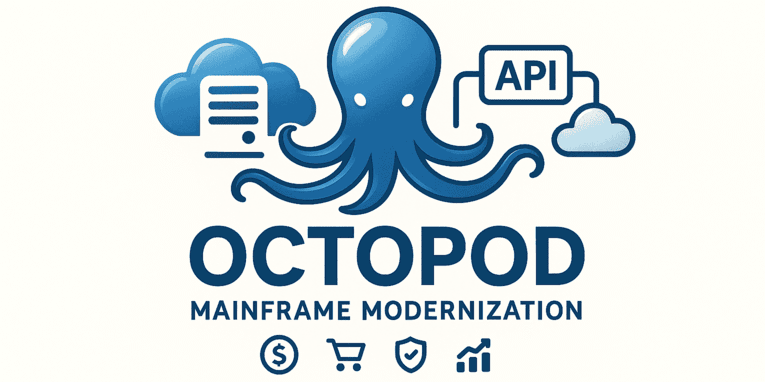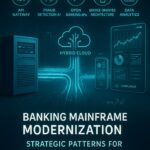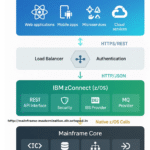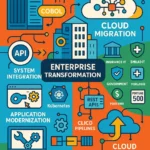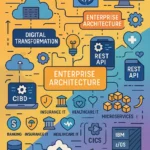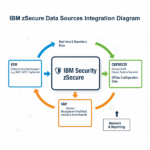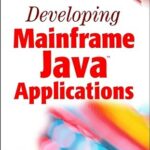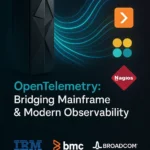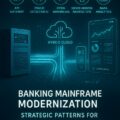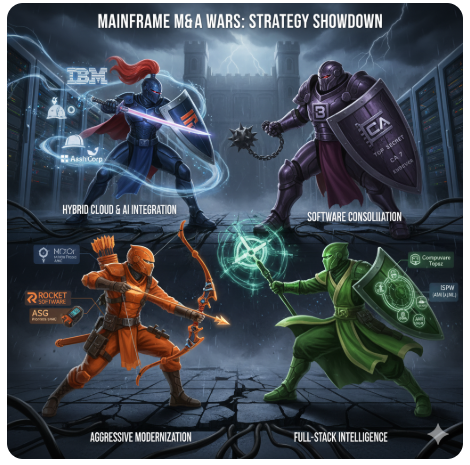Executive Guidance for CEOs, CIOs, Technology Directors, and IT Leadership
Executive Summary
Mainframe modernization represents a critical strategic inflection point for enterprises managing decades of mission-critical applications. The mainframe modernization market is estimated to grow from USD 8.39 billion in 2025 to USD 13.34 billion by 2030, at a CAGR of 9.7%, reflecting the urgent need for organizations to address aging infrastructure while maintaining operational continuity.
This guide provides executive leadership with a comprehensive analysis of the modernization landscape, covering major platforms including AWS BluAge, IBM Watson Code Assistant for Z, Microsoft Azure with Raincode, and specialized vendors like Astadia and LzLabs. Successful transformations require executive leadership that addresses organizational, financial, and risk management complexities alongside technical migration decisions.
The Strategic Business Case
Financial Reality Check
Initial TCO projections often underestimate the full transformation costs. Successful modernizations typically require 18-36 month timelines with budgets that should account for parallel system operations, extensive testing, and organizational change management. The most successful programs approach modernization as a multi-year strategic initiative rather than a tactical IT project.
Risk vs. Reward Framework
Mainframe applications typically represent 60-80% of an organization’s core business logic. The risk of disrupting these systems should be carefully weighed against the strategic benefits of cloud agility, developer productivity, and operational cost reduction. Executive leadership should establish clear risk tolerance and success metrics before technical work begins.
The Institutional Knowledge Crisis
Your Competitive Moat is Walking Out the Door
The business logic embedded in your mainframe applications represents decades of competitive differentiation, regulatory compliance, and operational refinement. This institutional knowledge—how your business actually works—often exists only in the minds of retiring employees and undocumented code modifications.
The brutal reality: That mainframe developer who’s been with your company for 30 years and understands why the payroll system does that mysterious calculation every month? They’re likely retiring soon. Automated tools can convert COBOL syntax, but they may not convert the understanding of why that code was written that way.
Strategic Recommendation: Treat knowledge preservation as a board-level crisis. Allocate 30% of your modernization budget to documentation and knowledge transfer before touching any code. Most failed migrations collapse not because of technical complexity, but because teams discover critical business rules that were never documented.
Comprehensive Vendor Landscape Analysis
Major Cloud Platform Solutions
AWS BluAge and Mainframe Modernization
AWS BluAge provides sophisticated automated refactoring capabilities with comprehensive cloud integration. The platform includes:
- AWS GapWalk Runtime: Acts as a compatibility layer between modernized COBOL applications and cloud-native environments, providing unified REST-based entry points
- API Integration: Modernized mainframe applications can be exposed as REST services
- Transaction Management: Maintains transaction integrity during migration
- Incremental Migration: Supports gradual exposure of mainframe functionality
Strategic Considerations:
- AWS naturally benefits from organizations moving their entire technology stack to the cloud
- While hybrid architectures are supported, they’re viewed as transition states rather than permanent solutions
- Performance overhead from additional runtime layers may impact transaction throughput
- Creates ongoing dependency on AWS-specific runtime infrastructure
IBM Watson Code Assistant for Z
IBM’s AI-driven approach enables refactoring of monolithic applications and mixed-language debugging, providing:
- Modern IDE Integration: Unified developer experience across Java and COBOL using Visual Studio Code
- AI-Augmented Development: Generative AI assistance for code modernization
- In-Place Modernization: Potentially maintains closer integration with existing mainframe infrastructure
- Mixed-Language Support: Seamless debugging across different programming languages
Strategic Considerations:
- May support maintaining existing IBM infrastructure investments
- AI assistance could address tribal knowledge preservation challenges
- Different modernization philosophy compared to cloud-first approaches
- Leverages existing IBM relationship and support structures
Microsoft Azure with Raincode
Raincode provides seamless migration to Azure without changing a single line of code, transforming monolithic legacy applications into micro or service-oriented architecture. Key capabilities include:
- Zero Code Change Migration: Raincode delivers technology for incremental, risk-free projects for mainframes with a much larger number of MIPS
- .NET Integration: Facilitate new development and maintenance in C#
- Azure AKS Support: Applications can run in separate containers for better scalability
- Cost Reduction: Freedom from COBOL licensing costs
Strategic Considerations:
- Strong partnership with Microsoft for comprehensive Azure integration
- Proven track record with large-scale migrations including insurance companies
- Focus on maintaining existing application behavior while modernizing infrastructure
- Comprehensive emulation capabilities for complex mainframe environments
Specialized Modernization Vendors
Astadia
Astadia positions 2025 as a prime opportunity for modernization, addressing obsolete technology, shrinking workforce, and increasing costs. Their approach includes:
- Five-Phase Process: Transform legacy COBOL-based mainframe systems into cloud-native, microservice-based architectures, emphasizing modularization, containerization, CI/CD integration
- Partnership Strategy: 25-year partnership with Micro Focus and collaborations with cloud providers
- Government Experience: Successful USAF migration of IMDS Logistics & Maintenance system from legacy mainframe to Azure
- Comprehensive Services: From initial assessment through production deployment
Strategic Considerations:
- Extensive experience across government and enterprise sectors
- Strong focus on cloud-native architectures rather than lift-and-shift approaches
- Emphasis on modern DevOps practices and observability
- Proven ability to handle complex, mission-critical systems
LzLabs (Note: Legal Considerations)
LzLabs offers the Software Defined Mainframe (SDM) platform for rehosting applications. However, the U.K.’s High Court ruled that a subsidiary of LzLabs GmbH reverse-engineered IBM software to create its mainframe modernization product, posing an existential threat to the vendor’s future business and risk to enterprise IT organizations that use it.
- Rehosting Approach: Move IBM Z mainframe applications to any popular cloud without the need to recompile programs or reformat data
- Partnership Network: Astadia provides systems integration and modernization services from initial assessment through production on LzSDM
Strategic Considerations:
- Legal uncertainties following IBM lawsuit ruling
- Evaluate risk tolerance for ongoing legal challenges
- Consider alternative vendors with clearer intellectual property positions
- Assess impact on long-term vendor relationship and support
Additional Market Players
The modernization ecosystem includes numerous global systems integrators and specialized consulting firms that provide services-led approaches to transformation. These organizations typically combine deep mainframe expertise with modern cloud capabilities, often partnering with technology vendors to deliver end-to-end solutions. Many focus on specific industry verticals or geographic markets, bringing localized expertise and regulatory knowledge to complex modernization programs.
Executive Decision Framework
Platform Strategy Evaluation Matrix
When comparing modernization approaches, consider:
1. Technical Approach
- Rehost: Move applications as-is to new infrastructure (Raincode, LzLabs)
- Refactor: Convert code to modern languages while preserving functionality (AWS BluAge)
- Modernize in Place: Update development practices while maintaining infrastructure (IBM Watson)
- Re-architect: Transform into cloud-native, microservice architectures (Astadia)
2. Vendor Relationship Strategy
- Single Vendor: Complete solution from one provider (AWS, IBM, Microsoft)
- Best-of-Breed: Combine specialized vendors for optimal outcomes
- Hybrid Partnership: Mix vendor solutions with internal capabilities
3. Risk Management
- Big Bang vs. Incremental: Balance transformation speed with operational risk
- Vendor Lock-in: Evaluate long-term flexibility and exit strategies
- Knowledge Preservation: Ensure critical business logic documentation
- Compliance Continuity: Maintain regulatory requirements throughout transition
Success Metrics Beyond Cost
Measure modernization success through business outcomes:
- Time-to-market for new product features
- Developer productivity and talent retention
- Regulatory compliance and audit efficiency
- Customer experience improvements
- Operational resilience and scalability
Strategic Recommendations for Leadership
1. Portfolio-Based Approach
Not every mainframe application needs the same modernization strategy:
- Modernize: Customer-facing systems requiring agility and integration
- Maintain: Stable, compliant systems with limited business change requirements
- Replace: Applications where commercial solutions provide better ROI
- Retire: End-of-life systems that can be decommissioned
2. Vendor Selection Strategy
- Multi-vendor Evaluation: Multiple viable options improve negotiating positions across different vendors
- Proof of Concept: Test critical applications with shortlisted vendors
- Reference Validation: Engage with similar organizations who have completed modernizations
- Legal Due Diligence: Ensure clear intellectual property rights and licensing
3. Organizational Transformation Requirements
Executive Sponsorship is Non-Negotiable
Failed modernization programs typically lack sustained C-suite commitment when projects encounter inevitable complexity. Successful transformations require:
- Dedicated executive sponsor with P&L accountability
- Cross-functional steering committee including business stakeholders
- Clear communication strategy for organization-wide change management
- Investment in upskilling existing talent alongside new cloud capabilities
4. Integration Architecture Strategy
Consider coexistence patterns during modernization transitions:
- Hybrid Integration Patterns: Integration architectures between mainframe and cloud during transition
- Strangler Fig Approach: Gradual replacement of mainframe functionality while maintaining system stability
- API-First Design: Expose modernized services through consistent interfaces
- Data Strategy: Plan for data migration, synchronization, and governance
The Strategic Modernization Decision
The mainframe modernization landscape offers multiple viable pathways, each with distinct advantages and considerations. AWS BluAge provides comprehensive cloud integration with automated refactoring capabilities. IBM Watson Code Assistant offers AI-augmented modernization while potentially preserving existing infrastructure investments. Microsoft Azure with Raincode enables zero-code-change migration to cloud infrastructure. Specialized vendors like Astadia provide deep expertise in cloud-native transformations.
The strategic consideration for executives centers on aligning modernization investments with long-term technology strategy, risk tolerance, and organizational capabilities. Successful transformations consistently demonstrate that technology capabilities must be matched with organizational readiness, executive commitment, and a clear understanding of business objectives.
Key Success Factors:
- Executive Commitment: Sustained C-suite sponsorship through inevitable challenges
- Knowledge Preservation: Document institutional knowledge before technical migration
- Incremental Approach: Balance transformation speed with operational continuity
- Vendor Partnership: Select partners aligned with long-term strategic objectives
- Success Metrics: Define business outcome measures beyond cost reduction
The modernization decision ultimately reflects each organization’s unique combination of technical debt, business requirements, risk tolerance, and strategic objectives. The abundance of viable solutions means success depends more on execution excellence and organizational change management than on selecting the “perfect” technology platform.
This analysis reflects insights from enterprise modernization programs across financial services, insurance, and government sectors. Successful transformations consistently demonstrate that technology capabilities must be matched with organizational readiness and executive commitment.
